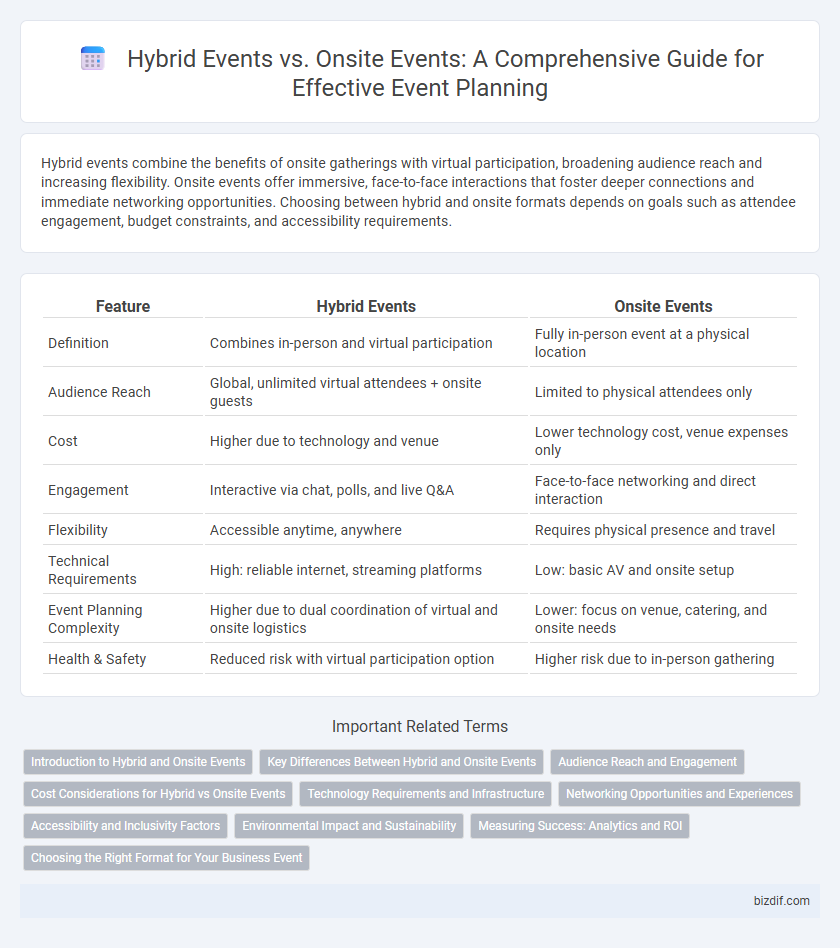Hybrid events combine the benefits of onsite gatherings with virtual participation, broadening audience reach and increasing flexibility. Onsite events offer immersive, face-to-face interactions that foster deeper connections and immediate networking opportunities. Choosing between hybrid and onsite formats depends on goals such as attendee engagement, budget constraints, and accessibility requirements.
Table of Comparison
| Feature | Hybrid Events | Onsite Events |
|---|---|---|
| Definition | Combines in-person and virtual participation | Fully in-person event at a physical location |
| Audience Reach | Global, unlimited virtual attendees + onsite guests | Limited to physical attendees only |
| Cost | Higher due to technology and venue | Lower technology cost, venue expenses only |
| Engagement | Interactive via chat, polls, and live Q&A | Face-to-face networking and direct interaction |
| Flexibility | Accessible anytime, anywhere | Requires physical presence and travel |
| Technical Requirements | High: reliable internet, streaming platforms | Low: basic AV and onsite setup |
| Event Planning Complexity | Higher due to dual coordination of virtual and onsite logistics | Lower: focus on venue, catering, and onsite needs |
| Health & Safety | Reduced risk with virtual participation option | Higher risk due to in-person gathering |
Introduction to Hybrid and Onsite Events
Hybrid events combine in-person attendance with virtual participation, allowing organizers to reach a broader audience and enhance engagement through digital tools. Onsite events take place exclusively at a physical location, offering direct networking opportunities and immersive experiences. Choosing between hybrid and onsite formats depends on factors like target audience, budget allocation, and desired interaction level.
Key Differences Between Hybrid and Onsite Events
Hybrid events combine physical attendance with virtual participation, allowing broader audience reach and increased flexibility compared to onsite events, which are held exclusively at a physical location. Onsite events prioritize face-to-face networking and immersive experiences but often involve higher travel and venue costs. Technology integration, attendee engagement methods, and data collection capabilities also differ significantly between hybrid and onsite events.
Audience Reach and Engagement
Hybrid events combine onsite and virtual participation, significantly expanding audience reach by enabling remote attendees to join from anywhere in the world. Onsite events foster deeper engagement through face-to-face interactions, immersive experiences, and networking opportunities. Leveraging hybrid event technology enhances real-time engagement metrics such as Q&A participation, polls, and chat interactions, bridging the engagement gap between physical and virtual audiences.
Cost Considerations for Hybrid vs Onsite Events
Hybrid events often require investment in advanced technology and platform subscriptions, increasing upfront costs compared to traditional onsite events that primarily involve venue, catering, and logistics expenses. However, hybrid events can reduce overall expenses by minimizing travel, accommodation, and physical setup costs for remote attendees and speakers. In contrast, onsite events typically incur higher spending on space rental and in-person staffing, making hybrids potentially more cost-effective for reaching larger, geographically dispersed audiences.
Technology Requirements and Infrastructure
Hybrid events demand advanced technology infrastructure, including high-speed internet, professional audiovisual equipment, and robust streaming platforms to ensure seamless integration between virtual and onsite participants. Onsite events primarily require reliable on-location technical support, including sound systems, lighting, and connectivity to support in-person engagement without extensive virtual components. Investing in scalable cloud-based event management software optimizes coordination for hybrid events, whereas onsite events benefit from localized network setups and real-time technical troubleshooting capabilities.
Networking Opportunities and Experiences
Hybrid events combine the advantages of onsite experiences and virtual accessibility, expanding networking opportunities by allowing in-person and remote attendees to connect via interactive platforms. Onsite events foster deeper personal interactions and spontaneous conversations, creating immersive environments that enhance relationship-building and collaboration. Leveraging hybrid formats optimizes engagement by integrating digital tools like live chats, breakout rooms, and social media feeds, enriching the overall networking experience.
Accessibility and Inclusivity Factors
Hybrid events enhance accessibility by allowing remote participation, accommodating diverse needs such as mobility limitations and geographic barriers, which onsite events may restrict. Onsite events provide direct interpersonal engagement but can face challenges catering to varying physical access requirements and inclusivity standards. Incorporating hybrid models improves overall inclusivity by blending physical presence with digital access, ensuring broader audience reach and equitable participation.
Environmental Impact and Sustainability
Hybrid events significantly reduce carbon footprints by minimizing travel-related emissions compared to onsite events, supporting sustainability goals through decreased transportation and accommodation needs. Onsite events typically consume more resources, including energy and waste generation, due to the concentrated physical presence of attendees and event infrastructure. Emphasizing hybrid event models can foster greater environmental responsibility while maintaining participant engagement across diverse locations.
Measuring Success: Analytics and ROI
Hybrid events generate comprehensive analytics by tracking both virtual engagement metrics and physical attendance data, enabling precise measurement of audience reach and interaction. Onsite events primarily rely on in-person feedback, attendance tracking, and direct sales impact to evaluate success, which can limit the scope of data compared to hybrid formats. Combining online and offline data in hybrid events enhances the accuracy of ROI calculations, providing deeper insights into attendee behavior and overall event effectiveness.
Choosing the Right Format for Your Business Event
Selecting the appropriate event format depends on audience reach, engagement objectives, and budget constraints, with hybrid events combining in-person and virtual elements to maximize accessibility and interaction. Onsite events offer immersive networking and direct experience, ideal for brand impact and relationship building in a controlled environment. Evaluating factors such as technological infrastructure, attendee preferences, and logistical capabilities ensures alignment with business goals and optimal event outcomes.
Hybrid events vs Onsite events Infographic

 bizdif.com
bizdif.com